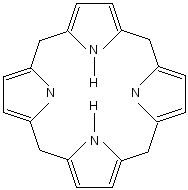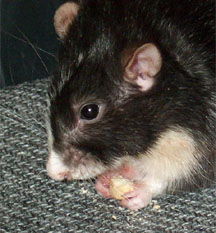Those red tears: porphyrin and the Norway rat
What is porphyrin?
 |
 |
|
|
|
The porphyrins are actually an enormous group of organic compounds, found all over the living world. The special
thing about porphyrins is that they bind metals. The four nitrogens in the middle of the porphyrin molecule act as
teeth: they can grab and hold metal ions such as magnesium (Mg), iron (Fe), zinc (Zn), nickel (Ni), cobalt (Co),
copper (Cu), and silver (Ag).
|
|
|
Chemical structure of ferroporphyrin, a porphyrin molecule that has an iron ion in the middle. |
Chlorophyll, the all-important molecule that allows plants to capture the sun's energy, and is responsible for plants' green color, is made up in part of a porphyrin molecule whose central metal ion is magnesium (Mg). The vitamin B12 consists of a porphyrin molecule with a cobalt ion in the middle.
So, porphyrins are an extremely important group of organic compounds. They are universal, found in most living
cells of animals and plants, where they perform a wide variety of functions.
Porphyrin and Norway rats
To the rat enthusiast, one porphyrin is of particular interest: the one that is secreted by the Harderian gland and appears around the rat's eyes. This red substance looks like red tears or blood, and can be startling to those who are unfamiliar with rats. Occasional low levels of porphyrin staining are normal, but regular large amounts of porphyrin indicate stress, sickness, or poor diet.
The Harderian gland
The Harderian gland (or Harder's lacrimal gland) was first described by a Swiss physician named Johann Harder in 1694 in a red deer. Harderian glands are found in all vertebrates (mammals, birds, reptiles, amphibians) that possess a nictitating membrane, or third eyelid, and are especially large in ungulates and rodents. They are located behind the eyeball in the orbit, at the base of the nictitating membrane, encircling the optic nerve. Humans have a rudimentary one.
The Harderian gland contains photoreceptors, and may be sensitive to light, like the eye itself (Vaughan et al. 1988, Lythgoe 1984). So, while it cannot see images like the eye can, it can still sense light, and it may help regulate the pineal gland (Feria-Velasco 1983, Wetterburg et al. 1970, but see Blackshaw and Shaw 1997).
The Harderian gland is an exocrine gland. Harderian secretions coat the eye, and drain down into the nose through the nasolacrimal duct. The rat may smear the secretions around his nose and fur with his paws during grooming.
Harderian gland secretions: lipids, melatonin and porphyrin
|
|
|
Slight porphyrin staining around a rat's nostril |
In the rat, in addition to these lipids, the Harderian gland produces melatonin as well as porphyrin (Djeridane and Touitou 2001, Rohonyi and Kelenyi 1962).
The porphyrin produced by the Harderian gland in rats is mostly protoporphyrin IX (PPIX), which does not have a central metal ion (Cui et al. 2003). The porphyrin is stored within the gland (Djeridane 1996, 1994). Dried porphyrin glows pink under ultraviolet light (Towbin et al. 1945).
Harderian porphyrin production increases with age for most of the rat's life: twenty month old rats produce more porphyrin than three month old rats. This natural increase reverses around age two: two year old rats produce less porphyrin than 20 month old rats (Rodriguez et al. 1992).
The function of Harderian porphyrin in rats is poorly understood. It may help protect the eye from light, as
porphyrin is increasingly excreted in response to light (Hugo et al. 1987, but see Shirama et al.
1987). Porphyrin stored in the Harderian gland responds to UV and blue light, causing an increase in secretion (Cui
et al. 2003). Porphyrin may also regulate the action of certain enzymes within the Harderian gland (Cardalada
et al. 1997).
The overproduction of porphyrin in rats
Rats sometimes produce profuse amounts of porphyrin in their Harderian gland secretions. The porphyrin-filled tears overflow the eye and dry on and around the eyelids, forming a dark red crust, a condition called chromodacryorrhea (KRO-mo-DAK-re-o-re-uh). The secretions drain from the eye into the nose, and once there may overflow the nostrils and dry around that area as well. The rat may then wipe the secretions with its paws, leading to red-stained paws and muzzles. Occasional small amounts of porphyrin are normal, but large, regular amounts indicate an underlying problem.
Rats overproduce porphyrin when they are stressed, ill, or poorly fed. Acute stress, such as limb restraint (Harkness and Ridgeway 1980), sleep deprivation (Hipolide and Tufik 1995), water deprivation (Figge and Atkinson 1945, but see Harkness and Ridgeway 1980), joint pain (Harper et al. 2001, Kerins et al. 2003), morphine withdrawal (Buccafusco 1990), acetylcholine injections (Harkness and Ridgeway 1980), and exposure to electric fields (Rommereim et al. 1990) have been found to cause chromodacryorrhea.
The onset of porphyrin overproduction after a stressor is variable. After injection with acetylcholine, for example, profuse amounts of porphyrin were secreted almost immediately and overflowed the eye to stain the eyelids within minutes. Rats experiencing limb restraint started producing copious amounts of porphyrin within 17-30 minutes (range 3-40 minutes). The larger the rat, the shorter its latency to produce porphyrin. In restrained rats, porphyrin was produced for about two hours, then it ceased (Harkness and Ridgeway 1980).
A number of diseases are also associated with the overproduction of porphyrin, such as corynebacterium, mycoplasmosis, salmonelliosis, and sialodacryoadenitis (SDA) (USF Div. Comp. Med. PDF ref). Dietary deficiencies may cause porphyrin overproduction as well (Sakai 1981).
These lists are not comprehensive, but rather go to show that porphyrin overproduction is a non-specific response to stress, pain, disease, or poor diet.
The Harderian gland in other species
The Harderian gland's function may differ in other species (Payne 1994) — Harderian glands in birds are involved in the immune response (e.g. Scott and Savage 1996, Ohshima and Hiramatsu 2002), and may help with thermoregulation in gerbils (Grant and Thiessen 1989, Thiessen 1988). The Harderian gland secretions have been found to serve a pheromonal function in hamsters (Sokolov et al. 1994, Payne 1977) and gerbils (Thiessen and Harriman 1986), but it is as yet unclear whether Harderian gland secretions have a pheromonal function in rats too.

